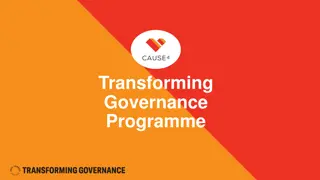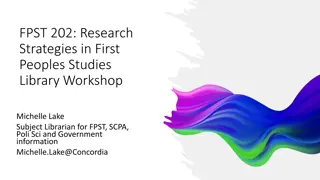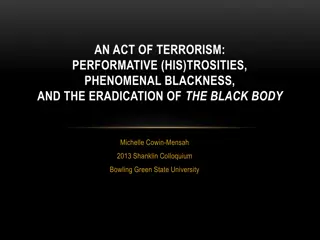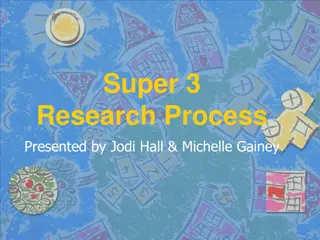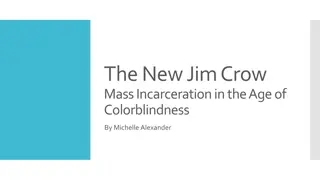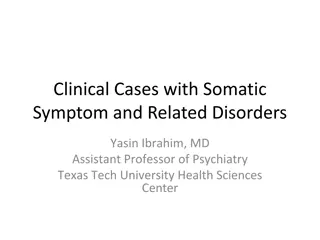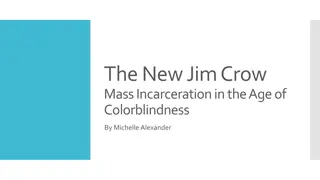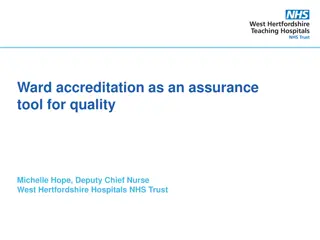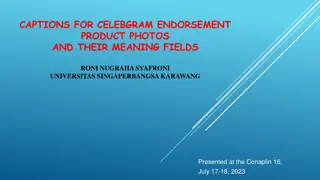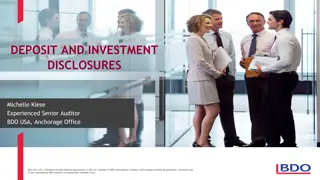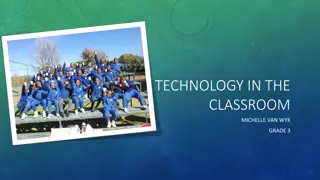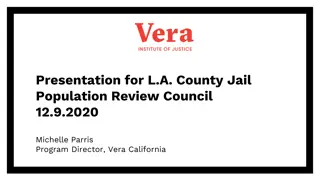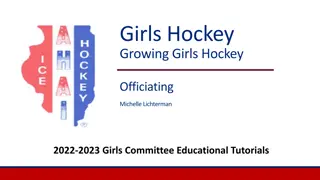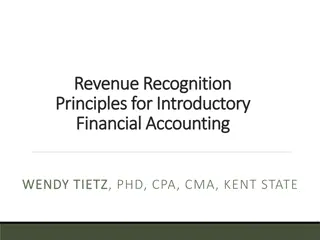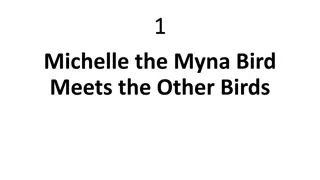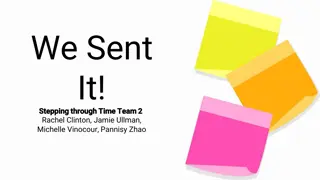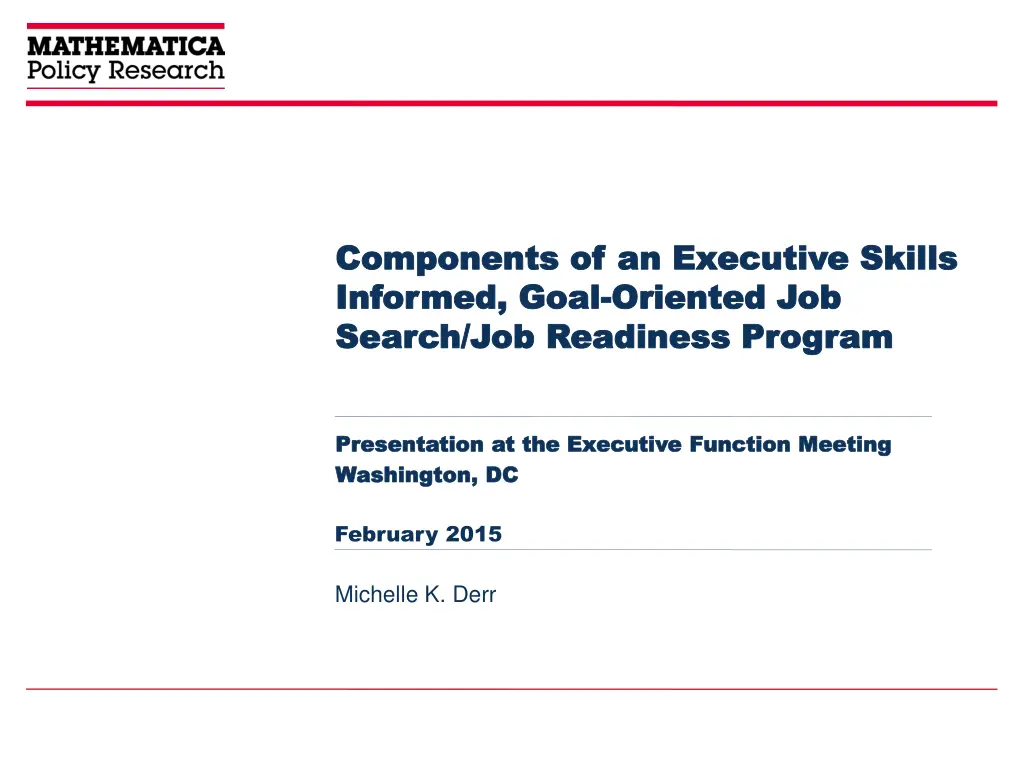
Effective Executive Skills and Goal-Oriented Program Development
Explore the development of executive skills and goal orientation in creating a job search/job readiness program. The presentation at an executive meeting in Washington, DC, highlighted components, goals, outcomes, obstacles, and a strategic plan for success. Learn how to enhance employment and training programs for low-income individuals and families through partnership and thoughtful processes.
Download Presentation

Please find below an Image/Link to download the presentation.
The content on the website is provided AS IS for your information and personal use only. It may not be sold, licensed, or shared on other websites without obtaining consent from the author. If you encounter any issues during the download, it is possible that the publisher has removed the file from their server.
You are allowed to download the files provided on this website for personal or commercial use, subject to the condition that they are used lawfully. All files are the property of their respective owners.
The content on the website is provided AS IS for your information and personal use only. It may not be sold, licensed, or shared on other websites without obtaining consent from the author.
E N D
Presentation Transcript
Components of an Executive Skills Components of an Executive Skills Informed, Goal Informed, Goal- -Oriented Job Oriented Job Search/Job Readiness Program Search/Job Readiness Program Presentation at the Executive Function Meeting Presentation at the Executive Function Meeting Washington, DC Washington, DC February 2015 Michelle K. Derr
WOOP 2
Wish Work in partnership with TANF agencies (at all levels) and our dream team to create an effective and feasible employment and training program that improves short- and long-term outcomes for low- income individuals and families. 3
Outcome Improve long-term employment and parenting outcomes and general well-being. 4
Obstacle Building a model that honors the evidence, but is simple to implement. Moving quickly enough to capitalize on the opportunities and energy, but slowly enough to create a smart and thoughtful process. Creating a model that is affordable for states and localities. 5
Plan Actively contribute to the dream team s vision, passion, and grit around this initiative. Continue to involve both researchers and TANF agencies in the model development and implementation. Create a thoughtful strategic plan that includes doable activities, useful products, and timely process. Be fiscally conscious AND develop the business case for policymakers highlighting the opportunity costs of investing in this practice model. 6
WOOP Your Program How do you see the executive skills and goal-oriented concepts playing out in your program? What is the wish for your program? What is your best outcome? What is the main obstacle? What is the plan? 7
Draft Core Program Components Goal Attainment Process BEST Resources Coaching Organizational Integration 9
Goal Attainment Process Set Establish meaningful, achievable goals Plan Develop a plan for meeting goals Act Put the plan into action Review/Revise Review the plan to assess what worked and revise it as necessary Worker serves as a facilitator the client owns their plan Backward planning process where there is an overarching goal with smaller steps to achieve it 10
Behaviorally-based Executive Skills and Troubleshooting (BEST) Resources Resources for identifying and troubleshooting problem behaviors that interfere with goal attainment Accessible, user-friendly tools for direct service staff Modularized resources that are anchored in executive and other motivational skills Recommendations for: Reducing the things that impair executive skills (e.g., stress, lack of sleep) Reducing the demands on executive skills Building executive skills 11
Coaching Progress is achieved through simple steps Coach models healthy behaviors Practice, practice, practice Affirming, corrective feedback Use of incentives and consequences to encourage desired behavior 13
Organizational Integration Invest in a top down, bottom up approach Infuse the goal attainment process and executive skills at all levels within the organization Start the goal attainment process from the initial conversation and throughout service delivery 14
What might this look like in the field? Implementation of different components of the pyramid Possible mix of individual and group activities Toolkit of resources to create quality, consistency, and fidelity in service delivery Measures of progress and short- and long-term outcomes 15
How is this different than current practice? Model is anchored in the best available evidence Effort to change the framing and language that is empowering and still maintains accountability Intentionality of smaller steps leading to bigger goals Changes the relationship between direct service provider and client where the client owns the plan Use of adult learning principles and dialogue education practices for staff training and direct service materials Use of test and tweak approach where evaluation helps inform and improve policy and practice decisions 16
Next Steps Strategic plan for process and partnerships Deciding on model options and an implementation plan Assessing existing fiscal and organizational resources and identifying additional needs CBPP, Mathematica, Abt, Global Learning Partners ACF (OPRE, OFA), state and local sites Recruiting and developing test sites Develop a flexible, evolving evaluation plan 17
Discussion questions: What are your reactions? What do you find useful? What questions come up for you? 18
For More Information Michelle Derr MDerr@mathematica-mpr.com 19


